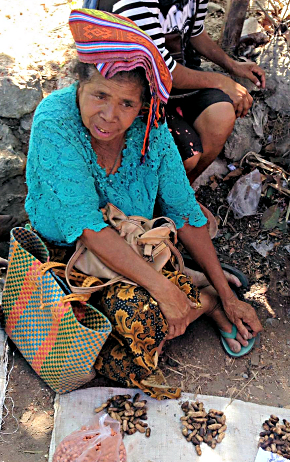| |
 mouse over to magnify mouse over to magnify
| | | | 325 Timor, West Timor
Mau naek (men's wrap)
| | Locale: | Noebesa village, close to Niki-Niki, North Amanuban | | Period: | 1970 | | Panels: | 1 | | Design: | This mau is highly unusual, in that the warp has been ikated over its full length, instead of leaving a blank in the midsection, where the warp cannot be ikated as it runs over the warp beam. On Sumba this problem is resolved by first ikating the midsection, then shifting it in place. It appears that the dyer was inspired by this Sumbanese technical solution.One one other example of this technique was encountered. The whole field is decorated with interlinked large geckos, small human figures in various colourful attire, roosters, chicks and birds in flight, all arrayed in such a manner as to create a meta-layer consisting of overlapping circles that remind one of jilamprang patola - though such patola were not common on Timor. Woven ca. 1970 by Maria Liunuma (depicted below), the grandmother of the person who sold it to the previous owner. The weaver signed the cloth with her initials, 'ML' (not a common practice on Timor), which of course got mirrored in the second layer of the warp. | | Size: | 93 x 246 cm (36.6 x 96.8 in) | | Weight: | 550 g (240 g/m2) | | Yarn: | Cotton, commercial, fine, quadruple-ply | | Comment: | Remarkably, this sizeable cloth (93 cm wide!) was made as . While the thread used was machine made (very soft, rich feeling cotton), only natural dyes were used. The cloth was field acquired by the previous owner in the village of origin directly from the weaver's family. To elaborate a point made by Garrett Kam when this cloth was posted on Facebook (29 Sept. 2019), when someone qualified it as less impressive than patola: with just minor variations the jilamprang patolas are all the same, century after century. They were made by professional weavers in ateliers. This cloth is the highly original creation of a single weaver in a small Timorese village. Just to be able to visualize it requires great artistic intelligence - something few would expect from an uneducated woman in a Timorese backwater. It is a powerful testimony to the abilities of Timorese weavers.
 | | Background: | Additional information in chapters on Timor and West Timor. | | Published: | Timor: Totems and Tokens, 2019.
Ikat Textiles of Timor: Indonesian and Timor-Leste, 2025. | | Sources: | All information regarding the dyer was provided by James Izacc Bill Key Kase. He also chased the artist down and provided the photograph. The only other Timorese ikat cloth decorated over the full lenght of the warp is in the collection of James Izacc Bill Key Kase, a keen collector, who is making exemplary contributions to the documentation of Timorese ikat. | | |
 ©Peter ten Hoopen, 2025
All rights reserved.
|
|


